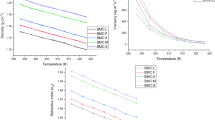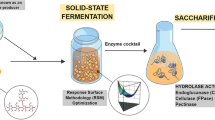Abstract
Enzymatic hydrolysis of naringin by the action of naringinase is one of the standard practices adopted in the citrus fruit juice industry for debittering. In the present study, a submerged fermentation condition was optimized for producing naringinase from Aspergillus niger van Tieghem MTCC 2425. As per Placket–Burman design, pH (3–5), incubation temperature (26–30 °C), and inducer concentration (12–18 g·L−1) were the most important factors influencing the naringinase production. Naringin from citrus waste was used as an inducer. A rotatable central composite design was employed on these three variables and the numerical optimization predicted that fermentation at 29.8 °C, pH 4.7, and inducer concentration of 14.9 g L−1 would yield a maximum naringinase activity of 545.2 IU g−1. During partial purification, ion exchange chromatography led to a 9.92-fold increase in enzyme activity resulting a specific activity of 5460 IU g−1 with an activity recovery of 17%. As reflected by SDS–PAGE profile, the partially purified naringinase showed the molecular weight bands of 10–20, 65, and 80 kDa, respectively. The purified form of enzyme showed optimum stability at pH 5 and 50 °C. The naringinase activity was completely retained up to 150 days when stored at 4 °C.



Similar content being viewed by others
References
Zhu, Y., Jia, H., Xi, M., Li, J., Yang, L., & Li, X. (2017). Characterization of a naringinase from Aspergillus oryzae 11250 and its application in the debitterization of orange juice. Process Biochemistry, 62, 114–121. https://doi.org/10.1016/j.procbio.2017.07.012.
Patil, S. V., Koli, S. H., Mohite, B. V., Patil, R. P., Patil, R. R., Borase, H. P., & Patil, V. S. (2019). A novel screening method for potential naringinase-producing microorganisms. Biotechnology and Applied Biochemistry., 66(3), 323–327. https://doi.org/10.1002/bab.1728.
Puri, M., & Banerjee, U. C. (2000). Production, purification, and characterization of the debittering enzyme naringinase. Biotechnology Advances, 18(3), 207–217. https://doi.org/10.1016/s0734-9750(00)00034-3.
Yadav, M., Sehrawat, N., Sharma, A. K., Kumar, V., & Kumar, A. (2018). Naringinase: microbial sources, production and applications in food processing industry. The Journal of Microbiology, Biotechnology and Food Sciences, 8(1), 717–720.
Puri, M., Banerjee, A., & Banerjee, U. C. (2005). Optimization of process parameters for the production of naringinase by Aspergillus niger MTCC 1344. Process Biochemistry, 40(1), 195–201.
VinothKumar, V., Kayambu, P., & RevathiBabu, S. (2010). Optimization of fermentation parameters for enhanced production of naringinase by soil isolate Aspergillus niger VB07. Food Science and Biotechnology, 19(3), 827–829.
Thammawat, K., Pongtanya, P., Juntharasri, V., & Wongvithoonyaporn, P. (2008). Isolation, preliminary enzyme characterization and optimization of culture parameters for production of naringinase isolated from Aspergillus niger BCC 25166. Kaestsart Journal of Natural Science, 42, 61–72.
Karuppaija, S., Kapilan, R., & Seevaratnam, V. (2016). Optimization of naringinase production by Rhizophus stolonifer in solid state fermentation media using paddy husk as support. Scholars Academic Journal of Biosciences, 4(6), 507–514. https://doi.org/10.21276/sajb.2016.4.6.10.
Puri, M., Kaur, A., Barrow, C. J., & Singh, R. S. (2011). Citrus peel influences the production of an extracellular naringinase by Staphylococcus xylosus MAK2 in a stirred tank reactor. Applied Microbiology and Biotechnology, 89(3), 715–722. https://doi.org/10.1007/s00253-010-2897-4.
Kumar, V. V. (2010). Comparative studies on inducers in the production of naringinase from Aspergillus niger MTCC 1344. African Journal of Biotechnology, 9(45), 7683–7686.
Dutt, K., Gupta, P., Saran, S., Misra, S., & Saxena, R. K. (2009). Production of milk-clotting protease from Bacillus subtilis. Applied Biochemistry and Biotechnology, 158(3), 761–772.
Purama, R. K., & Goyal, A. (2008). Application of response surface methodology for maximizing dextransucrase production from Leuconostoc mesenteroides NRRL B-640 in a bioreactor. Applied Biochemistry and Biotechnology, 151(2–3), 182–192.
Singh, R. S., Singh, H., & Saini, G. K. (2009). Response surface optimization of the critical medium components for pullulan production by Aureobasidium pullulans FB-1. Applied Biochemistry and Biotechnology, 152(1), 42–53.
Shehata, A. N., El Aty, A., & Abas, A. (2014). Optimization of process parameters by statistical experimental designs for the production of naringinase enzyme by marine fungi. International Journal of Chemical Engineering, 2014(3), 1–10. https://doi.org/10.1002/bab.1728.
Puri, M., Kaur, A., Singh, R. S., & Singh, A. (2010). Response surface optimization of medium components for naringinase production from Staphylococcus xylosus MAK2. Applied Biochemistry and Biotechnology, 162(1), 181–191.
Shanmugaprakash, M., Kirthika, J., Ragupathy, J., Nilanee, K., & Manickam, A. (2014). Statistical based media optimization and production of naringinase using Aspergillus brasiliensis 1344. International Journal of Biological Macromolecules, 64, 443–452. https://doi.org/10.1016/j.ijbiomac.2013.12.033.
Mukund, P., Belur, P. D., & Saidutta, M. B. (2013). Production of naringinase from a new soil isolate, Bacillus methylotrophicus: isolation, optimization and scale-up studies. Preparative Biochemistry and Biotechnology, 44(2), 146–163. https://doi.org/10.1080/10826068.2013.797910.
Raval, K., Gehlot, K., & Prasanna, B. D. (2017). Scale-up of naringinase production process based on the constant oxygen transfer rate for a novel strain of Bacillus methylotrophicus. Preparative Biochemistry and Biotechnology, 47(2), 192–198. https://doi.org/10.1080/10826068.2016.1201680.
Bradford, M. M. (1976). A rapid and sensitive method for the quantitation of microgram quantities of protein utilizing the principle of protein–dye binding. Analytical Biochemistry, 72(1–2), 248–254.
Laemmli, U. K., Molbert, E., Showe, M. K., & Kellenberger, E. (1970). Form determining function of the genes required for the assembly of the head of bacteriophage T4. Journal of Molecular Biology, 49(1), 99–113.
Galbraith, J. C., & Smith, J. E. (1969). Filamentous growth of Aspergillus niger in submerged shake culture. Transactions of the British Mycological Society, 52(2), 237–246.
Norouzian, D., Hosseinzadeh, A., Inanlou, D. N., & Moazami, N. (2000). Production and partial purification of naringinase by Penicillium decumbens PTCC 5248. World Journal of Microbiology and Biotechnology, 16(5), 471–473.
Saranya, D., Shahmugam, S., Kumar, S., Thayumanavan, B., & Rajasekaran, P. (2009). Purification and characterization of naringinase from Candida tropicalis. Advance Biotechnology, 9, 11–13.
Awad, G. E., El Aty, A. A. A., Shehata, A. N., Hassan, M. E., & Elnashar, M. M. (2016). Covalent immobilization of microbial naringinase using novel thermally stable biopolymer for hydrolysis of naringin. 3 Biotech, 6(1), 14. https://doi.org/10.1007/s13205-015-0338-x.
Acknowledgments
The authors express their sincere gratitude to the Department of Biotechnology, Government of India for financial support during the research.
Author information
Authors and Affiliations
Corresponding author
Ethics declarations
Conflict of Interest
The authors declare that they have no competing interests.
Ethical Statement
This research does not include any studies or trials with human participants or animals.
Additional information
Publisher’s Note
Springer Nature remains neutral with regard to jurisdictional claims in published maps and institutional affiliations.
Rights and permissions
About this article
Cite this article
Borkar, V., Chakraborty, S. & Gokhale, J.S. Fermentative Production of Naringinase from Aspergillus niger van Tieghem MTCC 2425 Using Citrus Wastes: Process Optimization, Partial Purification, and Characterization. Appl Biochem Biotechnol 193, 1321–1337 (2021). https://doi.org/10.1007/s12010-020-03385-9
Received:
Accepted:
Published:
Issue Date:
DOI: https://doi.org/10.1007/s12010-020-03385-9




